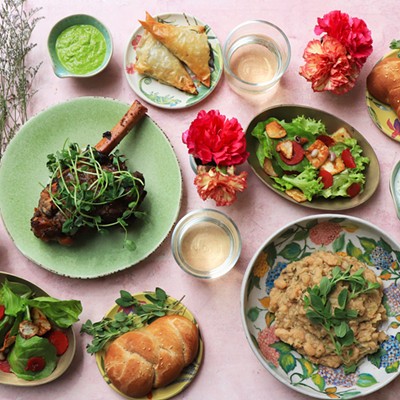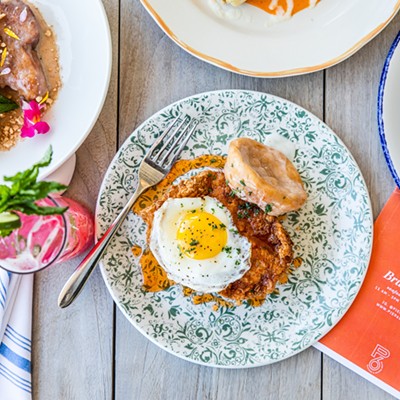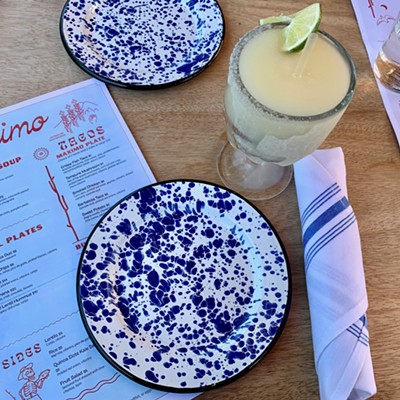Robb Walsh last did a vertical tasting of all the Saint Arnold Divine Reserve (DR) brews back in 2008, and three more DRs have been released in the ensuing years: DR 7, a Weizenbock; DR 8, a Scotch ale; and DR 9, a very autumnal Imperial pumpkin stout. Now, the brewery and its fans are eagerly awaiting the release of the 10th Divine Reserve, an English barleywine based on a recipe created by local homebrewer Chris Landis.
In anticipation of the DR 10 -- which will hit shelves on November 2 in its typical limited production fashion, causing citywide panic as hopheads scramble to grab a six pack for themselves -- Brock Wagner, founder of Saint Arnold, invited me and the Chron's Ronnie Crocker to the brewery last week to see how the beers have evolved since the first Divine Reserve was bottled in 2005.
So exactly how does five-year-old beer taste? Better than you'd think.
Only one of the nine beers that we tasted had aged poorly. Wagner was careful to keep them all in a cold box from the moment they were bottled until now -- he learned the hard way that beers don't age well at room temperature.
"All beers oxidize," Wagner explained, whether they're kept cold or at room temp. "Beers oxidize both ways, but the cold oxidization brings out some positive aspects of the beer."
The DR 3, a double IPA that was bottled in September 2006, had oxidized in one of the less positive ways and smelled like wet cardboard the moment the cap came off. But the other eight beers had transformed over time into different versions of their younger selves, some entirely for the better.
The only Divine Reserve that I've abjectly disliked was the DR 8, created by local homebrewer Phillip Kaufman. My reaction to the beer -- described as a "bold, malty, smoky Scotch ale" -- was that it was overwhelmingly sweet and tasted as if someone had poured liquid smoke directly into the fermenting tank. But in just over a year since it was bottled -- August 2009, to be more precise -- the beer had developed into a much more typical tasting Scotch ale. It was still sweet and lacked a counterbalance, but I didn't actively dislike it anymore. The smoke had mellowed considerably, as had the syrupy taste.
The beer that surprised me the most was the oldest of the batch: the DR 1, an unfiltered dry-hopped barleywine bottled in October 2005. It tasted as fresh as the day it was brewed although it had clarified over time; the cloudiness that had been so prevalent when it was first bottled was gone, the sediment sitting at the bottom of the bottle (the bottles are stored upright as they age, not like wine bottles). It was malty and subtly sweet, with a taste that was a mixture of chocolate and molasses.
The DR 6, an American barleywine bottled in June 2008, might be a bit easier to find these days on places like eBay and other trading boards if you don't have a stash for yourself at home. It has aged spectacularly, with an intensely piney nose that fades after about five minutes and mellows into a beautifully hoppy beer with a dry finish.
Wagner attributes the success of the Divine Reserves in part to three assets that make the beers untouchable and immune from replication: the homebrewers that submit recipes for the yearly Big Batch Brew Bash (three DRs so far are the result of winning entries in the contest), his own talented brewers in-house and one important ingredient.
"The secret is our yeast," Wagner says with a grin, of the brewery's top secret and proprietary yeast strain that's used in all their beers. "I'll give you the recipe for any of our beers, but without the yeast they won't taste the same." These aren't beers that any other brewery could produce, making the limited runs each year that much more special.
But there's good news for those who want to enjoy the limited production Divine Reserves in greater quantity: Thanks to Saint Arnold's recent move into a larger facility, the production of DR 10 will be doubled this year.
That doesn't mean there won't be a mad scramble for the stuff, of course. Have you prepared for the release of Divine Reserve No. 10?





